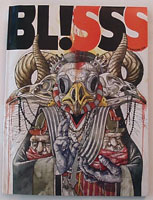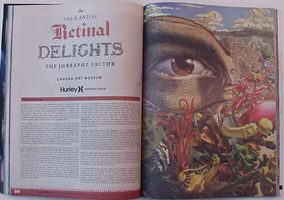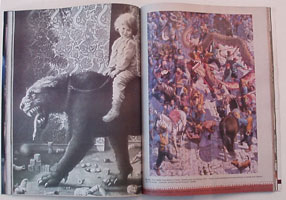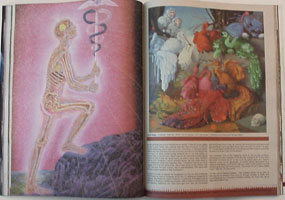
In
the Land of Retinal Delights : The Juxtapoz Factor
By Nathan Spoor
BL!SSS Magazine
Vol.2 No.7
Growing up in Houston, TX, skateboarding and drawing were the things to
do. Thanks to the visionaries behind “Future Primitive” I had
an entire universe to explore, as it opened my brain to the amazing world
beyond
my reach, but accessible at all moments. It wasn’t just their world,
or my world, it was ours for the taking. Stacy Peralta and CR Stecyk III
had, in essence, turned a page of history and revealed something that was
there all along. Freedom. Actually, it went so far as to influence every
major outlet at the time, including MTV.
And how had I come by this piece of magic, you may ask? Thrasher Magazine.
Thrasher was the kind of raw energy that actually made up skateboarding
and art. It was put together and presented with the same ferocity and
sincerity that was at the core of any skateboarder of that second
surge in the 80’s.
Around that same time, my best skate bro handed me a cassette tape of a new
hair metal band that was shredding everything within earshot. The skatepark
would put it on loop, and Robert Williams’ artwork inside Guns n’ Roses “Appetite
for Destruction” would send my brain reeling. I now had a vision
of where my Pushead and Jim Phillips inspired ink drawings could grow.
Surviving car wrecks and physical therapy will reset anyone’s mind
about whether to catch up with sponsors or heal. And anyways, I was about
to go to college to search out more meaning in the path to pursuing the
arts. As a beginning painter, I started looking for more like-minded
creations in art rags of the day. But the art magazines of the 90's were
pretty slim
pickings if you wanted inspirational visual content. No, what you'd get
was
the sort of thin excuses for insult that Artforum (theoretical, overly
intellectual, snobbish, condescending to the point that when it comes
in the mail you end
up just getting mad at it) could snob up. Art in America had some interesting
things and some good art, but the stories put you to sleep. It wasn't
as snobby or theoretical or brutal, but it was boring. And ArtNews was
just
sensational. Even with its heists and updates it was more about how much
art cost and how rich collectors were and, sadly, less about the art
or the artists.
It was in late 2000 that I would find a light with Juxtapoz #29. It was
the Todd Schorr cover and boasted R. Crumb, HR Giger, Mark Mothersbaugh,
Rick
Griffin, Stanley Mouse (not a bad place to start, looking back). Finally
there was a voice. The kind of art that I'd always wished would exist
did in fact exist! Fausto Vitello did a serious solid for the whole industry
actually. Here was a magazine that was about guys that could relate to
you.
Yeah you - the artist, the surfer, the skateboarder, the big dreamer.
They weren't trying to snob us out or pull one over. Finally, there was
a magazine
that showcased some of the most amazing artists and ignited imaginations
nationwide and quickly, worldwide.
Juxtapoz has grown since it's inception in ‘94. Visionaries Robert
Williams, Fausto Vitello, CR Stecyk III and Greg Escalante made sure
of that. They infused it with the art and culture that spawned a new
generation
of
talented thinkers and doers. Arguably, the action sports industry would
never be the same again. Ripples were being made. And not just ripples,
but splashes.
Some are large splashes that left giant pools of thought and integrity
across the land. While some smaller splashes were capable of soaking
an entire community
with a single image and several strokes of brilliant brushwork.
And so it goes that the counter culture would eventually find itself
in the grips of being recognized for what it was – effective and brilliant
action. There was a need, and whether it was small at the time it would be
a seed that would grow into a pretty impressive organism. An entity that
is finally recognized at a major museum of documentary importance – The
Laguna Art Museum.
The current exhibition at the Laguna Art Museum, curated by Meg Linton
(Director of the Ben Maltz Gallery and Public Programs at Otis College
of Art and Design
in Los Angeles), boasts a good range of the artists that Juxtapoz has
featured in its 14 years. The magazine's curator, Greg Escalante, comments
on the
progression between standup paddleboard sessions: "I first noticed this
myself when I got a Thrasher in '87 with Williams on the cover. It was like
Salvador Dali was reincarnated into some Hollywood surrealist. I opened up
the pages and was in awe. There was nothing else like that anywhere. It had
all the pulp references, and it was retro with conviction. I collected Robert
Williams and then followed the trail of artists and found Chaz Bojorquez
and a bunch of other artists being featured at La Luz and ended up showing
them in Jux as well. There was an art movement really taking place in LA,
but if only we could come up with a name. Well, Williams came up with "lowbrow",
which actually stuck. No one really liked it, but I understood what his meaning
was. "Lowbrow" carried so much baggage with it at the same
time, like it was dumb or low culture. But what I saw was the new culture,
like
it was Newbrow. The name with the most weight recently is Pop Surrealism."
He takes a minute to adjust his longboard on the car and continues, "Fast
forward to now to Juxtapoz being the #1 selling art magazine in existence.
Now there's a major museum in California, the oldest cultural institution
in Southern California actually, with a history of documenting and collecting
California art. And they get this new art movement and are giving them
credit by hosting this amazing art exhibition and documenting it as it
has been
grown and nurtured into what it is now. It's not just about California,
it's more global and the museum is putting its stamp on it as a real
art movement."
The exhibition truly is the magazine come to life, as the museum showcases
the real originals of the art that started it all. If you want the proof
it's there for all to see in all its grand glory and shame. Whether you're
an art appreciator, an action sports participant or a sideline cheerleader,
you'll want to get your eyes on this exhibit and find something to wrap
your mind around. The waves are all in there. Make one or ride one, it's
your
world.
“In the Land of Retinal Delights - The Juxtapoz Factor” is
on view at the Laguna Art Museum from June 22 through October 5, 2008,
and is
accompanied by a full-color exhibition catalog. For more info: lagunaartmuseum.org



